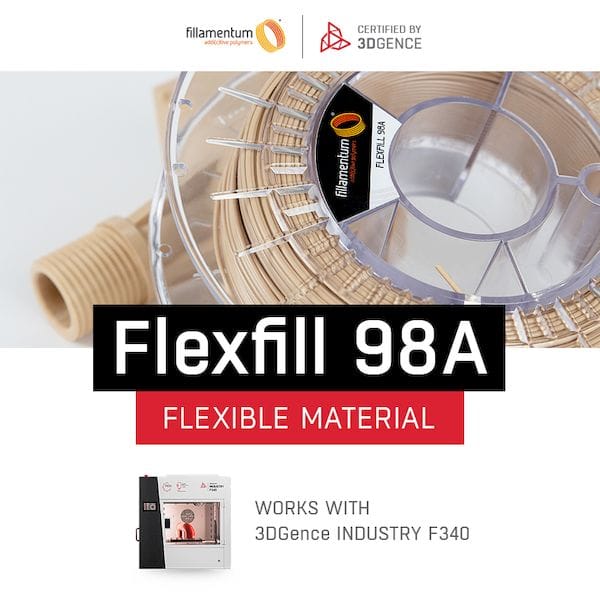![Filamentum’s Flexfill 98A has been certified for use on the 3DGence F340 [Source: 3DGence]](https://fabbaloo.com/wp-content/uploads/2020/05/image-asset_img_5eb093ad8659b.jpg)
3DGence has added a new flexible material to their list of certified-for-use materials.
The Poland-based company has been producing industrial 3D printers for several years and offers a unique system to handle multiple types of materials: swappable extrusion modules.
The problem with extrusion / FFF 3D printers is that there really is no single design of an extrusion system that can handle all types of materials. At the very least you will see companies offering swappable nozzles to overcome problems such as hard material wear. In other cases you may see a 3D printer manufacturer offer different extrusion systems entirely.
3D printing flexible materials is one of the more challenging issues in FFF 3D printing. The problem with flexible filament is that it bends easily. This is not good when the extruder is attempting to push the spaghetti-like material into a small hole. Very often the flexibility causes the filament to bend rather than follow the intended filament path, causing a jam.
To overcome this different designs for extruders have been made, mostly attempting to minimize the distance the flexible filament must travel without guidance from sidewalls. In every case the print speed must be dramatically lowered, otherwise even the slightest back pressure will cause one of these bends to occur.
Very often you’ll see a 3D printer advertised something like this: “Prints all materials (except flexible)”. That’s because 3D printing flexible material is really hard to do reliably.
Flexfill 98A
We were thusly surprised to see 3DGence’s announcement that they’ve certified a flexible filament for use in their popular F340 industrial 3D printer. The specific filament involved seems to be Filamentum’s Flexfill 98A.
To be sure, Flexfill 98A is most definitely not the most flexible material you can get. In fact, Filamentum also offers Flexfill 92A. (The 92 and 98 refer to the Shore A hardness scale, with the larger number being less flexible.) 3DGence has selected and certified a semi-hard flexible material.
You can see here where these flexible materials lie on the hardness scale using this highly instructive chart obtained from Smooth-On:
![The Shore hardness scale [Source: Smooth-On ]](https://fabbaloo.com/wp-content/uploads/2020/05/image-asset_img_5eb093ade174d.jpg)
It’s not entirely clear which printing module 3DGence uses for the flexible filament, as they have not stated so in their announcement. Currently, the company offers four swappable modules to handle:
-
PRO Module: For low-temperature common materials
-
HF Module: For low-temperature large-volume printing with a wider nozzle
-
HT Module: For medium-temperature material such as PC
-
HTmax Module: For very high-temperature materials such as PEEK
If I had to guess, I’d say they’re probably using their PRO module, as it is listed as supporting TPU, a flexible material. [UPDATE] We’ve confirmed with 3DGence that the PRO module is used for this material.
3D Print Flexible Replacement Parts
![A replacement CNC machine hood 3D printed in flexible material [Source: 3DGence]](https://fabbaloo.com/wp-content/uploads/2020/05/flexfill-98a-print_img_5eb093ae30940.jpg)
The other thing to note is that the F340’s build volume is quite large at 260 x 300 x 340 mm. This makes it then feasible to 3D print rather large flexible objects. One print made by 3DGence demonstrates the capability by producing a replacement accordion-style hood for a CNC machine, as seen here:
![A replacement CNC machine hood 3D printed in flexible material [Source: 3DGence]](https://fabbaloo.com/wp-content/uploads/2020/05/image-asset_img_5eb093ae8b487.jpg)
This particular replacement was interesting as 3DGence says the regular replacement part was to take at least two weeks to arrive, leaving the expensive CNC machine out of action for some time. That’s definitely not good for any workshop that endeavors to keep all machines running and making money.
Instead of waiting, they were able to 3D print a replacement hood using Flexfill 98A that worked quite well. This put the CNC machine back in action after only a day of outage, saving countless dollars in potentially lost revenue.
Via 3DGence











Formlabs announced a new resin, Tough 1500 Resin, which has some interesting properties and could be used as a substitute for polypropylene.